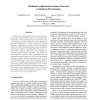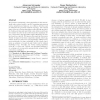714 search results - page 81 / 143 » Time and energy complexity of distributed computation in wir... |
ICDCSW
2009
IEEE
14 years 3 months ago
2009
IEEE
—The number of active nodes in a WSN deployment governs both the longevity of the network and the accuracy of applications using the network’s data. As node hibernation techniq...
SENSYS
2003
ACM
14 years 2 months ago
2003
ACM
The current generation of sensor nodes rely on commodity components. The choice of the radio is particularly important as it impacts not only energy consumption but also software ...
DC
2008
13 years 8 months ago
2008
A MAC protocol specifies how nodes in a sensor network access a shared communication channel. Desired properties of a MAC protocol are: it should be contention-free (avoid collisio...
ICDCS
2005
IEEE
14 years 2 months ago
2005
IEEE
The process of computing the physical locations of nodes in a wireless sensor network is known as localization. Selflocalization is critical for large-scale sensor networks becaus...
PODC
2009
ACM
14 years 9 months ago
2009
ACM
We present a randomized coloring algorithm for the unstructured radio network model, a model comprising autonomous nodes, asynchronous wake-up, no collision detection and an unkno...


